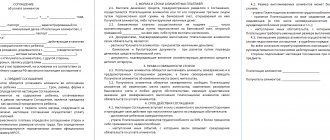Home / Family law / Rights and obligations / Rights of spouses / Origin of children
Back
Published: 04/17/2017
Reading time: 4 min
2
10905
If a couple had a child, but they were not in an official relationship, then to recognize paternity, it is necessary to submit an application to the registry office.
However, there are situations when a couple is in a long-term relationship, after which a child is born, and the father refuses to go to the registry office for voluntary recognition of the newborn.
In such cases, recognition of paternity and collection of alimony through the court will be required. You will learn how to do this by studying this article.
- Establishing paternity in court
- Procedure for considering a claim
- How to fill out an application
- What documents are required
- Challenging paternity
- Legal consequences
- Establishing paternity and collecting alimony
- Conclusion
Dear readers! To solve your problem, call hotline 8 or ask a question on the website. It's free.
Ask a Question
Establishing paternity in court
Compulsory establishment of paternity in court is regulated by the Family Code, in particular Articles 49 and 51. The circumstances under which court proceedings will be necessary are as follows:
- the father of the newborn died before he could voluntarily acknowledge himself as the father;
- the father refuses to recognize himself as such.
The law also allows not only the mother of the child to apply for recognition of paternity through the court, but also:
- persons who have a dependent child;
- guardians;
- the child himself is over 18 years of age.
Important : there is no statute of limitations for recognizing paternity in legislative acts, so legal proceedings can be initiated at any time.
The father can independently file a claim for recognition of paternity in court in cases where the mother of the newborn died and they did not have time to register their relationship.
It is also possible to initiate legal proceedings when the mother refuses to voluntarily register the child with the registry office or if she is declared incompetent.
The jurisdiction of cases of challenging paternity falls within the scope of activity of civil courts, namely district courts.
In order to initiate legal proceedings, the mother of the child must draw up a statement of claim to the court at the place of registration and attach all the necessary documents to it.
Arbitrage practice
When analyzing Russian judicial practice, it is worth noting that a significant part of the cases being considered to determine paternity and establish child support are resolved in favor of single mothers and in defense of the rights of minors. Exceptions are situations where the plaintiff was careless in the selection of documentary evidence and testimony.
If, in the opinion of the court, the evidence attached to the claim and the information heard from witnesses is not enough to make a fair decision, in accordance with Art. 79 of the Code of Civil Procedure of the Russian Federation, a medical genetic examination is prescribed. Participation in the research must be voluntary for both the plaintiff and the defendant. Evasion from conducting an examination, Part 3 of Art. 79 of the Code of Civil Procedure of the Russian Federation is interpreted against a person who interferes with the establishment of the truth through medical manipulation. The court accepts the evidence of the second party in its entirety and makes a decision in its favor.
An example from judicial practice. Sorokina E. filed a statement of claim in court against Surovtsev E. with demands to establish paternity of her minor daughter and to recover the amount of alimony payments. In essence, the plaintiff said that she lived for some time in the same territory and lived together with the defendant without concluding an official union. After the onset of pregnancy, Surovtsev E. refused to recognize the relationship with the child and register the emergence of parental responsibilities after the birth of his daughter. By her mother's decision, the minor girl received her surname. Information about the biological father was not stated on the birth certificate. Before Sorokina E. went to court, the father did not participate in raising the child and did not provide financial support. The fact of cohabitation between the plaintiff and the defendant is confirmed by the testimony of witnesses in the case. Surovtsev E. refused to appear at the court hearing and did not give permission to conduct a DNA examination. Guided by the provisions of the law on the rights of the child, set out in the Constitution, the Family Code, the Federal Law “On Acts of Civil Status”, in defense of the interests of a minor girl, the Rudnyansky District Court decided to recognize E. Surovtsev as the father and collect alimony from him (Decision of the Rudnyansky District Court of the Smolensk Region dated 08/07/2019 in case No. 2-342/2019).
To avoid the court making a refusal decision, the plaintiff must:
- Agree to conduct a genetic examination at the request of the court;
- Attend all court hearings;
- Present all possible evidence relevant to the situation under consideration.
The operative part of the judicial act does not confirm the establishment of paternity in the event that the child’s mother withdraws the statement of claim or in the absence of a blood relationship between the man and the child, as evidenced by the conclusion of a genetic examination.
Procedure for considering a claim
The procedure for consideration by the court of the application is carried out in accordance with the second section of the civil code. First, the court familiarizes itself with the case materials and, if necessary, calls representatives from each side to the hearing.
Next, an examination of the provided evidence is carried out. If the court decides that the information is not sufficient to recognize the father as such, a decision may be made to order a genetic examination.
If he refuses to submit material for study in order to confirm or refute his involvement in the birth of the child, the judge may decide to recognize him as the father.
After considering the case on its merits, a court decision is made to recognize the fact of paternity or to refute it.
Before the judicial act enters into legal force, each party may appeal the decision within the time limits established by law.
What does the Resolution of the Plenum of the Supreme Court of the Russian Federation of October 25, 1996 say?
This document talks about the fact that in cases of establishing paternity, challenging, demanding alimony funds, the court, when directly resolving the stated claims, is recommended to pay attention to the time of the emergence of legal relations between the parties and the rules for putting the RF IC into force.
If a man and a woman have a baby, but they are not married, then in the absence of a statement from the parties, the question of the origin of the child is considered by the judicial authorities in the manner of litigation.
The court can establish paternity at the request of a person who is not in an officially registered relationship with the child’s mother, if the latter suddenly died, was declared incompetent, or it is not possible to establish her place of residence.
Challenging paternity can have different grounds: infertility of the husband (wife), absence of the husband during the period of conception. There are no specific time limits for challenging.
If the baby was born before March 1, 1996, then the court is obliged to take into account that, by virtue of part five of article forty-nine Code of Law of Ukraine, such a record can be challenged within one year from the moment when the person registered as the baby’s father became aware of the recording of the second paragraph of paragraph number 10 of the Resolution of the Plenum of the Supreme Court of the Russian Federation dated October 25, 1996 No. 9.
How to fill out an application
As has already been said, in order to initiate proceedings to recognize paternity, it is necessary to correctly draw up and submit a statement of claim. You can view the current sample here.
First, you need to fill out the application header in the upper right corner. It contains the following information:
- name of the court site and its number;
- Full name of the applicant;
- Full name of the person to whom the claim will be addressed.
Further, after the words “statement of claim”, the plaintiff, represented by the woman who gave birth, indicates all the information about the potential father of the newborn, as well as the approximate time frame during which she became pregnant. Afterwards, it is necessary to indicate the circumstances why the defendant refused to participate in the registration of the child with the registry office.
It should be noted that if the defendant refuses to support the plaintiff, does not provide financial assistance and does not make contact.
Below should be listed all the evidence indicating that the father is the defendant. You can list them in the application as a list, but they must be attached along with the claim so that the court can familiarize itself with them.
The “please” paragraph contains information about the defendant, as well as, if necessary, to receive financial support, a request for alimony, which the defendant will be required to pay until the children reach adulthood.
Also, the plaintiff may request in his application to summon witnesses on his part to the meeting who can confirm the fact of paternity.
At the end, the date of completion is indicated and the statement of claim is certified by the signature of the plaintiff.
Statement of claim
The claim must include the following:
- Name of the court where it is filed.
- Personal information of the plaintiff and defendant - full names, dates of birth, place of residence, telephone numbers, etc.
- The circumstances of the case - when and where the intended parents lived, when the child was born, reasons for going to court, etc.
- List of evidence that confirms paternity.
- Plaintiff's claims. This can be either a single acknowledgment of paternity or a simultaneous collection of alimony.
- List of documents that are attached to the claim.
What documents are required
The plaintiff must attach the following documents when filing an application to consider the case on the merits:
- a receipt confirming payment of the state fee for filing a claim;
- child's birth certificate;
- death certificate, in cases where it is necessary to establish paternity after death;
- written evidence indicating that the father is the defendant.
The list may be supplemented with other evidence, for example, photo and video materials confirming paternity or documents with the results of genetic testing.
From what date will alimony be assigned?
According to Part 2 of Art. 107 of the RF IC, any alimony right arises from the date of filing a statement of claim for the collection of alimony. A claim to establish paternity and collect alimony is no exception. But there are some nuances: in these circumstances, the possibility of calculating alimony for past periods is excluded. This is due to the fact that the potential payer of alimony was not recognized as a father before the court decision came into force, that is, there was no legally proven event obliging the father to pay alimony.
Challenging paternity
A paternity dispute may arise when the family was married, but there was a break in the relationship and the spouses decided to divorce. Having one or more minor children, after a divorce, the father will be required to pay child support until they reach adulthood. However, the father may not do this for two reasons:
- during the divorce, they agreed with his wife that she would not demand alimony from him;
- he is not the children's biological father.
In the second case, such a situation can only be proven through the judicial authorities.
Also, proceedings will be necessary if the spouses decide to change the entry on the children’s birth certificate regarding the mark of paternity.
Contesting paternity follows the same principle as calling paternity.
The difference is that the father submits such an application. In the statement, the father indicates the reasons why the relationship with his wife was terminated and the grounds for recognizing that he is not considered the father of the children.
All necessary documents and evidence indicating this fact are attached to the application. Also, before filing a claim, it will be necessary to provide a receipt for payment of the state fee.
After the court’s decision to challenge paternity is issued, the plaintiff will receive documents that must be submitted along with an application to the registry office to change the entry on the children’s birth certificate.
How to apply for child support if paternity is established
When the paternity of the person being sued is an indisputable fact, Article 83 of the Family Code comes into play.
Based on them, the judge will determine the amount of monetary support.
Material payments will be assigned from the moment of filing a claim (Article 107 of the Insurance Code).
When the relationship of the spouses is officially registered, a marriage certificate is sufficient for the court to accept the application.
The certainty of paternity and documentary evidence of this in an unofficial marriage allows you to apply to the courts and demand funds for the maintenance of children on a general basis.
The law provides for two forms of payment of alimony by court:
- fixed amount;
- percentage of income.
The plaintiff has the right to choose the form of payment independently. Taking into account the financial situation of both parties and other significant points, the judge will make a final verdict.
In the absence of disputes or objections, the court will make a decision and issue an order on the amount of alimony and the payment procedure. This is how the defendant’s share of the earnings is determined. With a court order, you can contact the bailiffs and initiate enforcement proceedings.
Reference
A court order is issued if there is no dispute about paternity and payments are determined as shares of earnings.
Another method, a universal one, is for the court to schedule hearings, listen to both sides, and take into account all the evidence.
After the necessary procedures, it will make a final decision. The office will issue a writ of execution.
Before contacting the judicial authorities, it is worth preparing documents, as well as their copies:
- passport;
- child's birth certificate;
- document on registration or divorce (if available);
- paternity certificate.
Take care of:
- certificates about the family composition of both parents;
- calculation of alimony;
- providing evidence of the costs of maintaining a child;
- written confirmation of the father's income.
Certificate of paternity
The plaintiff provides complete information about himself and, if possible, the defendant. In the absence of such, he requests that measures be taken to search for the defendant.
Having collected a package of documents, you need to draw up a statement of claim. It states:
- name of the court;
- necessary information about both parties to the claim;
- plaintiff's claims;
- proof;
- amount of alimony.
3 copies of the application are required to initiate enforcement proceedings. One copy remains in court, the other two are intended for the plaintiff and defendant. The office processes the civil case. It is assigned a number by which you can check meeting times and track progress.
Based on the documents presented and the testimony of both parties, a decision will be made and time will be given to appeal it. After the court ruling comes into force, the bailiffs will accept it for execution.
Any claim is subject to tax. Alimony including. The state duty is 150 rubles. According to the norm of the Tax Code, the plaintiff is exempt from paying the fee. This responsibility is imposed on the defendant.
The state fee for establishing paternity is 300 rubles. The said amount is included in the claim at the request of the applicant.
Legal consequences
After the court's decision to recognize paternity in relation to the defendant comes into force, the plaintiff, represented by the mother, has the right to submit an application to the registry office. The application indicates a request to be recorded as the defendant's father. The basis for this will be a court decision.
After this, the mother must pay the state fee and attach a receipt to the application. Within 5 days from the date of payment, a corrected birth certificate of the child will be issued, with information about the father indicated on it.
Attention should also be paid to the situation when, in addition to recognizing the plaintiff as a father. There is a requirement to pay alimony. The defendant may not participate in the hearing and not defend his position. If the mother of the children is not aware of his whereabouts, then after a court decision is made in her favor, the recognized father will be put on the wanted list.
If we are talking about challenging paternity, then the court, taking the side of the plaintiff, issues a decision according to which, just like in the situation listed above, he can contact the registry office to change the entry in the children’s birth certificate. At this moment, all obligations in the form of paying alimony to minor children are removed from him until they turn 18 years old.
Where to file a claim
An application accompanied by a package of documents is submitted to the court office at the place of residence of one of the parties.
The plaintiff decides which institution to choose (Articles 28, 29 of the Code of Civil Procedure).
If there is confirmed paternity, in a dispute about alimony you should contact a magistrate (Article 23 of the Code of Civil Procedure). Each of them is assigned a site with addresses.
This procedure is called “jurisdiction”. On the website of the city court or in the institution itself, you can get information about the relationship of the residential address to a particular site, and find out the name of the justice of the peace.
If the defendant's paternity is a controversial issue, the district court will hear the case.
Establishing paternity and collecting alimony
Often, along with the condition of recognition of paternity, there are also requirements for the payment of child support to children under the age of 18. Based on the court decision, the father has obligations to provide his children with monetary allowance.
The amounts to be paid are established by law. Their size is regulated by Article 81 of the Family Code of the Russian Federation.
ATTENTION ! The amount of alimony will have to be withheld from the father’s salary and other income for 1 month. Its size can reach 50% of income if payments rely on 3 or more children.
The father must independently make monthly payments; if he evades them, the court may initiate enforcement proceedings.
This means that, based on a court decision, a writ of execution is issued to the bailiff authorities.
Afterwards, the bailiffs are obliged to inform the father and set a deadline for him to voluntarily repay the child support debt.
If the requirements are not met within the established period, the sheet will be sent to the debtor’s official work, where the employer will be obliged to withhold part of the salary to pay off the debt.
If we consider the return of alimony when challenging paternity, judicial practice shows that a fairly small percentage of cases are filed in such cases.
This is due to the fact that it is prohibited by law to return paid alimony. The only conditions under which this is possible:
- if the mother of the children knew, but hid the fact that the children were not from her husband, and the very fact of concealment was aimed with the intent of enrichment at the expense of paid alimony;
- if the father of the children was forced to agree to pay alimony and recognize the children as not his, under the threat of violence or death.
However, according to these two compositions, it is quite problematic to prove your case in court. This requires direct evidence in the form of audio or video materials or witness confessions.
Procedural features of consideration of cases involving DNA testing
At the moment, many couples simply live together without formalizing their relationship.
Sooner or later, lovers will find out that they are having a baby. Moreover, after the birth of a child, a lot of problems related to documents arise. You have to visit various government agencies to prove the paternity of the beloved new mother. Establishing paternity is a fact that necessarily entails the emergence of parental legal relations.
This is a way to help protect the interests of a child who has not yet turned eighteen years old. This is a set of various legal norms that regulate the relationship between parent and child. They arise in connection with determining the origin of the baby. Establishing paternity in court is a measure aimed at recognizing the violated rights of a minor.
Article forty-nine of the RF IC states that in the event of the birth of a child to citizens whose relationship is not officially formalized, in the absence of a mutual statement from the mother and father or a statement from the baby’s father, the origin of the child from a specific person is established exclusively in court.
The current Family Code does not establish specific deadlines for filing an application. It can be submitted at any time, regardless of how much time has passed since the birth of the child.
Establishing paternity in relation to a person who has reached the age of majority is permissible only with his consent. Cases to establish paternity are heard only by district courts. The process may take up to two months.
According to the rule established by current legislation, the claim must be filed at the place of residence of the defendant. When preparing a case to establish paternity during the consideration of the case, the judge, in order to obtain comprehensive answers to certain questions related to the origin of a particular child, has the right, taking into account the opinions of the parties, to order an examination.
It can be genetic, biological, forensic. It should be noted that the most reliable results can only be obtained through genetic testing (DNA).
A DNA test answers the following questions regarding the origin of children:
- paternity or maternity of a particular individual in relation to a particular child (fetus) is not excluded or excluded;
- if motherhood or paternity is not excluded, then what is the probability that the final result is not the result of a random coincidence of personal characteristics of completely strangers.
Progress does not stand still, so modern genetics makes it possible to reliably establish paternity both before and after the birth of a child. A DNA test can be done even during the mother's pregnancy. This can really be done if she is in the first trimester of pregnancy.
This method was developed in the laboratory of clinical genetics of the Scientific Center for Obstetrics and Gynecology. Genetics doctors did a DNA study of one woman (surrogate mother), who was at a certain stage of pregnancy. A married couple has doubts that the surrogate mother is carrying their baby.
During the study, it turned out that the mother was not a surrogate. At the time of implantation of the fertilized egg, she was already pregnant.
When the court has doubts about the objectivity and validity of the conclusion (for example, when the specialist did not take into account the circumstances or did not follow the procedure), additional research may be required.
This rule is based on the eighty-seventh article of the Civil Procedure Code of the Russian Federation. For example, a claim was considered to establish paternity and collect alimony from a citizen with whom the applicant had previously been in a relationship. The court ordered a DNA test.
The court later rejected the applicant's claim. It turned out that the blood sampling was carried out with serious violations. The court also considered that the joint photograph that the plaintiff provided was not sufficient as evidence that she was in a relationship with the child’s father.









